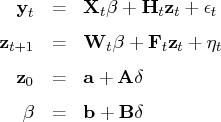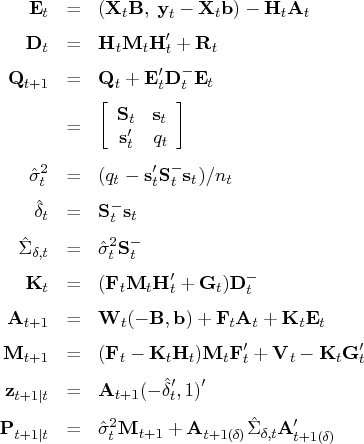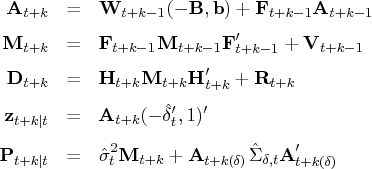| Language Reference |
KALDFF Call
computes the one-step forecast of state
vectors in an SSM by using the diffuse Kalman filter.
The call estimates the conditional expectation of
![]() , and also estimates the initial random
vector,
, and also estimates the initial random
vector, ![]() , and its covariance matrix.
, and its covariance matrix.
- CALL KALDFF( pred, vpred, initial, s2, data, lead, int, coef, var,
- intd, coefd <, n0, at, mt, qt>);
The inputs to the KALDFF subroutine are as follows:
- data
- is a
 matrix containing
data
matrix containing
data  .
. - lead
- is the number of steps to forecast
after the end of the data set.
- int
- is an
 matrix for a time-invariant
fixed matrix, or a
matrix for a time-invariant
fixed matrix, or a  matrix containing fixed matrices for the time-variant
model in the transition equation and the measurement equation -
that is,
matrix containing fixed matrices for the time-variant
model in the transition equation and the measurement equation -
that is,  .
. - coef
- is an
 matrix for a time-invariant
coefficient, or a
matrix for a time-invariant
coefficient, or a  matrix containing coefficients at each time in the
transition equation and the measurement equation -
that is,
matrix containing coefficients at each time in the
transition equation and the measurement equation -
that is,  .
. - var
- is an
 matrix for a
time-invariant variance matrix for the error in the transition
equation and the error in the measurement equation, or a
matrix for a
time-invariant variance matrix for the error in the transition
equation and the error in the measurement equation, or a
 matrix
containing covariance matrices for the error in the transition
equation and the error in the measurement equation - that
is,
matrix
containing covariance matrices for the error in the transition
equation and the error in the measurement equation - that
is,  .
. - intd
- is an
 vector containing
the intercept term in the equation for the initial
state vector
vector containing
the intercept term in the equation for the initial
state vector  and the mean effect
and the mean effect  -
that is,
-
that is,  .
. - coefd
- is an
 matrix containing
coefficients for the initial state
matrix containing
coefficients for the initial state  in the equation
for the initial state vector
in the equation
for the initial state vector  and the mean effect
and the mean effect
 - that is,
- that is,  .
. 
- is an optional scalar including an initial denominator.
If
 , the denominator for
, the denominator for  is
is  plus the number
plus the number  of elements
of
of elements
of  .
If
.
If  or
or  is not specified, the
denominator for
is not specified, the
denominator for  is
is  .
With
.
With  , the initial values,
, the initial values,  , and
, and
 , are assumed to be known and, hence,
, are assumed to be known and, hence,  ,
,  ,
and
,
and  are used for input containing the initial values.
If the value of
are used for input containing the initial values.
If the value of  is negative or
is negative or  is not specified,
the initial values for
is not specified,
the initial values for  ,
,  , and
, and  are computed.
The value of
are computed.
The value of  is updated as
is updated as
 after the KALDFF call.
after the KALDFF call.

- is an optional
 matrix.
If
matrix.
If  ,
,  contains
contains
 .
However, only the first matrix
.
However, only the first matrix  is used as input.
When you specify the KALDFF call,
is used as input.
When you specify the KALDFF call,  returns
returns
 .
If
.
If  is negative or the matrix
is negative or the matrix  contains
missing values,
contains
missing values,  is automatically computed.
is automatically computed.

- is an optional
 matrix.
If
matrix.
If  ,
,  contains
contains  .
However, only the first matrix
.
However, only the first matrix  is used as input.
If
is used as input.
If  is negative or the matrix
is negative or the matrix  contains missing values,
contains missing values,  is used for output,
and it contains
is used for output,
and it contains  .
Note that the matrix
.
Note that the matrix  can be used as an input matrix
if either of the off-diagonal elements is not missing.
The missing element
can be used as an input matrix
if either of the off-diagonal elements is not missing.
The missing element  is replaced
by the nonmissing element
is replaced
by the nonmissing element  .
. 
- is an optional
 matrix.
If
matrix.
If  ,
,  contains
contains  .
However, only the first matrix
.
However, only the first matrix  is used as input.
If
is used as input.
If  is negative or the matrix
is negative or the matrix  contains missing values,
contains missing values,  is used for
output and contains
is used for
output and contains  .
The matrix
.
The matrix  can also be used as an input
matrix if either of the off-diagonal elements is
not missing since the missing element
can also be used as an input
matrix if either of the off-diagonal elements is
not missing since the missing element  is replaced by the nonmissing element
is replaced by the nonmissing element  .
.
The KALDFF call returns the following values:
- pred
- is a
 matrix containing
estimated predicted state vectors
matrix containing
estimated predicted state vectors  .
. - vpred
- is a
 matrix
containing estimated mean square errors of predicted state
vectors
matrix
containing estimated mean square errors of predicted state
vectors  .
. - initial
- is an
 matrix containing an
estimate and its variance for initial state
matrix containing an
estimate and its variance for initial state  ,
that is,
,
that is,  .
. 
- is a scalar containing the estimated variance
 .
.
The KALDFF call computes the one-step forecast of state vectors in an SSM by using the diffuse Kalman filter. The SSM for the diffuse Kalman filter is written
It is assumed that the noise vector
where
An example that uses the KALDFF call is in the documentation for the KALDFS call.
Copyright © 2009 by SAS Institute Inc., Cary, NC, USA. All rights reserved.

![[ \eta_t \ \epsilon_t ] & \sim & n (0, \sigma^2 [ {v}_t & {g}_t \ {g}^'_t & {{r}}_t ] ) \ \delta & \sim & n(\mu, \sigma^2\sigma)](images/langref_langrefeq606.gif)


